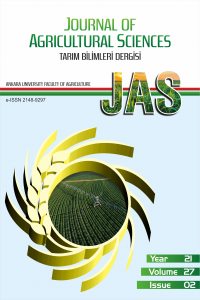Biostabilization of Tannery Sludge Compost by Vermicomposting
Biostabilization of Tannery Sludge Compost by Vermicomposting
Chemical properities, Eisenia foetida Tannery sludge compost, total chromium, vermicomposting,
___
- Referans 1: Ahlberg O, Gustafsson P & Wedel P (2006). Leaching of metals from sewage sludge during one year and their relation to particle size. Environmental Pollution 144:545-553.
- Referans 2: Bartlett R & James B (1979). Behavior of chromium in soils: III. Oxidation 1. J ournal of Environmental Quality 8 (1):31–35.
- Referans 3: Bremner J M & Mulvaney C S (1982). Nitrogen-total. In: Page AL, Miller RH, Keeney DR (editors). Methods of Soil Analysis: Part II. Chemical and Microbiological Properties. Madison, WI, USA: American Society of Agronomy, pp. 595-641.
- Referans 4: Cardossa‐Vigueros L & Ramirez‐Camperos E (2006). Tannery wastes and sewage sludge biodegradation by composting and vermicomposting process. Ingenieria Hidraulica En Mexico. 21(2):93-103.
- Referans 5: Delgado M, Bigeriego M, Walter I & Calbo R (1995). Use of California redworm in sewage sludge transformation. Turrialba. 45:33-41.
- ISSN: 1300-7580
- Yayın Aralığı: Yılda 4 Sayı
- Başlangıç: 1995
- Yayıncı: Ankara Üniversitesi
Murat YÜCEKAYA, Ahmet Salih GÜNAYDIN
Exponential Type Estimators Using Sub-Sampling Method with Applications in Agriculture
Özen Yusuf ÖĞRETMEN, Barış KARSLI, Emre ÇAĞLAK
Günce ŞAHİN, Mehmet ÖRGEÇ, Nusret ZENCİRCİ
Environmental Abiotic Stress and Secondary Metabolites Production in Medicinal Plants: A Review
Arjita PUNETHA, Dipender KUMAR, Priyanka SURYAVANSHİ, Rc PADALIA, Venkatesha K.T.
Determining the Relationship of Evapotranspiration with Precipitation and Temperature Over Turkey
Mustafa KUZAY, Mustafa TUNA, Mustafa TOMBUL
Effects of tillage method and drainage management on some soil physical properties
Mahmoud SHABANPOUR, Salman FEKRI, Iraj BAGHERI, Sayed Hossein PAYMAN, Fatemeh RAHİMİ-AJDADİ
Hussein Abdullah Ahmed AHMED, Güray AKDOGAN, Sancar Fatih ÖZCAN, Surendra BARPETE
Azin NAJAFABADİ, Jalal JALİLİAN
Fatih KAHRIMAN, Umut SONGUR, Abdullah DİŞBUDAK, Sezgin KIZIK, Berk VURAL
